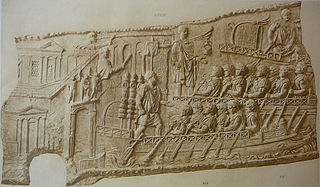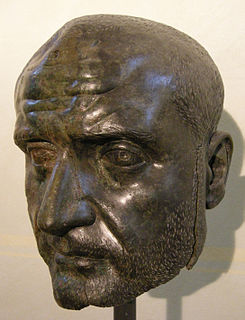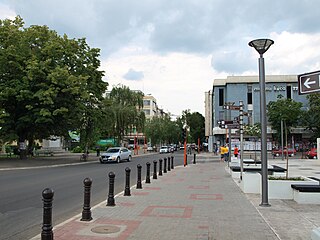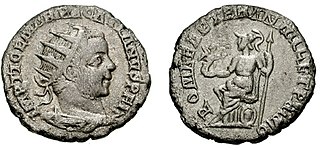 W
WMoesia was an ancient region and later Roman province situated in the Balkans south of the Danube River. It included most of the territory of modern-day Central Serbia, Kosovo, parts of Northern Albania and the northern parts of the modern North Macedonia, Northern Bulgaria, Romanian Dobrudja and Southern Ukraine.
 W
WAedava was a Dacian settlement located south of the Danube in Moesia. In his De Aedificiis, the 6th century AD historian Procopius placed Aedava on the Danubian road between Augustae and Variana. He also mentioned that Emperor Justinian restored the damaged portion of the town defenses.
 W
WAemilianus, also known as Aemilian, was Roman emperor for three months in 253.
 W
WAiadava was a Dacian town in the Remesiana region, present day Bela Palanka, Serbia.
 W
WAthanaric's Wall, also called Lower Trajan's Wall or Southern Trajan's Wall, was a fortification line probably erected by Athanaric, between the banks of river Gerasius and the Danube to the land of Taifali. Most probably, Athanaric's Wall has reused the old Roman limes called Limes Transalutanus.
 W
WBela Palanka is a town and municipality located in the Pirot District of southeastern Serbia. According to the 2011 census, the population of the town is 8,143, and the population of the municipality is 12,126. In ancient times, the town was known as Remesiana in Dacia Mediterranea. The name Bela Palanka means 'white town'.
 W
WVidin is a port town on the southern bank of the Danube in north-western Bulgaria. It is close to the borders with Romania and Serbia, and is also the administrative centre of Vidin Province, as well as of the Metropolitan of Vidin.
 W
WPart of a series of articles upon Archaeology of Kosovo
 W
WThe Classis Flavia Moesica was the Roman Empire's fleet on the lower Danube river, near the Black Sea.
 W
WGolubac is a village and municipality located in the Braničevo District of the eastern Serbia. Situated on the right side of the Danube river, it is bordered by Romania to the east, Veliko Gradište to the west and Kučevo to the south. The population of the village is 1,655 and the population of the municipality is 8,161. Due to many nearby archeological sites and the Đerdap national park, the village is a popular tourist, fishing and sailing destination.
 W
WThe Dardani were a Paleo-Balkan tribe, which lived in a region which was named Dardania after their settlement there. The eastern parts of the region were at the Thraco-Illyrian contact zone. In archaeological research, Illyrian names are predominant in western Dardania, while Thracian names are mostly found in eastern Dardania. Thracian names are absent in western Dardania; some Illyrian names appear in the eastern parts. Thus, their identification as either an Illyrian or Thracian tribe has been a subject of debate; the ethnolinguistic relationship between the two groups being largely uncertain and debated itself as well. The correspondence of Illyrian names - including those of the ruling elite - in Dardania with those of the southern Illyrians suggests a "thracianization" of parts of Dardania. Strabo in his geographica mentions them as one of the three strongest Illyrian peoples, the other two being the Ardiaei and Autariatae.
 W
WDasius of Durostorum is a Christian martyr of the early 4th century AD. He was a Roman soldier of Legio XI Claudiana at Durostorum, Moesia Inferior who was beheaded in the early 4th century after his refusal to take the part of "king" in the local Saturnalia celebrations.
 W
WTrajan Decius was Roman emperor from 249 to 251.
 W
WThe Diocese of Moesia was a diocese of the later Roman Empire, in the area of modern western Bulgaria, central Serbia, Montenegro, Albania, North Macedonia, and Greece.
 W
WSilistra is a town in Northeastern Bulgaria. The town lies on the southern bank of the lower Danube river, and is also the part of the Romanian border where it stops following the Danube. Silistra is the administrative center of the Silistra Province and one of the important towns of the historical region of Southern Dobrudzha.
 W
WGaius Vibius Trebonianus Gallus was Roman emperor from June 251 to August 253, in a joint rule with his son Volusianus.
 W
WThe German and Sarmatian campaigns of Constantine were fought by the Roman Emperor Constantine I against the neighbouring Germanic peoples, including the Franks, Alemanni and Goths, as well as the Sarmatian Iazyges, along the whole Roman northern defensive system to protect the empire's borders, between 306 and 336.
 W
WĆuprija is a town and municipality located in the Pomoravlje District of central Serbia. The population of the town is 19,380, while the municipality has 30,645 inhabitants.
 W
WThe Jireček Line is a conceptual boundary through the ancient Balkans that divides the influence of the Latin and Greek languages in the Roman Empire from Antiquity until the 4th century. A possible rough outline of it goes from near the city of Laç in modern Albania to Serdica and then follows the Balkan Mountains to Odessus (Varna) on the Black Sea or continuing along the coastline northwards to the Danube Delta. The placement of the line is based on archaeological findings as most of the inscriptions found to the north of it are written in Latin, and most of the inscriptions found to the south of it are in Greek.
 W
WThe Kingdom of Dardania was an independent state in the Balkans during classical antiquity. Dardania was mostly populated by Dardanians.
 W
WPart of a series of articles upon Archaeology of Kosovo
 W
WKraku Lu Jordan is archeological site in Serbia. It is situated at the confluence of the Brodica river into Pek, near Kučevo. Represents the most explored metallurgical center in eastern Serbia. The metallurgic occupation of the site lasted for about 100 years, beginning around 280 AD and ending in 380 AD. Kraku Lu Jordan is precisely dated by discovered coins from Diocletian time. This metallurgical complex was then destroyed in a fire in the late 4th century. Archaeological excavations began in 1971, and with few interruptions, lasted until 1987.
 W
WRam is a settlement in the municipality of Veliko Gradište, in the Braničevo District of Serbia. The town developed around the fortification of the same name.
 W
WLegio undecima Claudia was a legion of the Imperial Roman army. XI Claudia dates back to the two legions recruited by Julius Caesar to invade Gallia in 58 BC, and it existed at least until the early 5th century, guarding lower Danube in Durostorum.
 W
WThe Moesian Limes or Limes Moesiae is the modern term given to a collection of Roman fortifications between the Black Sea shore and Pannonia, present-day Hungary, consisting primarily of forts along the Danube to protect the Roman provinces of Upper and Lower Moesia south of the river.
 W
WThis is a list of Roman castra in Romania. They were built by the Roman army following the conquests of Moesia, Scythia Minor and Dacia, parts of which are now found in the territory of modern Romania. The Latin word castra, with its singular castrum, was used by the ancient Romans to mean buildings or plots of land reserved to or constructed for use as a military defensive position. Many of these castra were part of various limes.
 W
WMediana is an important archeological site from the late Roman period, located in the eastern suburb of the Serbian city of Niš. It represents a luxurious residence with a highly organised economy. Excavations have revealed a villa with peristyle, thermae, granary and water tower. The residence dates to the reign of Constantine the Great 306 to 337. Although Roman artifacts can be found scattered all over the area of present-day Niš, Mediana represents the best-preserved part of Roman Naissus. In 1979, Mediana was added to the Archaeological Sites of Exceptional Importance list, protected by the Republic of Serbia.
 W
WMoesia Prima was a frontier province of the late Roman Empire, situated in the central parts of present-day Serbia, along the south bank of the Danube River. Provincial capital was Viminacium, near modern Kostolac in Serbia).
 W
WPart of a series of articles upon Archaeology of Kosovo
 W
WNiš is the third largest city in Serbia and the administrative center of the Nišava District. According to the 2011 census, the city proper has a population of 183,164, while its administrative area has a population of 260,237 inhabitants.
 W
WNerodimë e Poshtme or Donje Nerodimlje is an archaeological site and village situated west of the city of Ferizaj, Kosovo. Several archaeological trenches were investigated at this location in 1988.
 W
WPart of a series of articles upon Archaeology of Kosovo
 W
WTiberius Claudius Marinus Pacatianus was a usurper in the Danube area of the Roman Empire during the time of Philip the Arab.
 W
WPart of a series of articles on Archaeology of Kosovo
 W
WPart of a series of articles upon Archaeology of Kosovo
 W
WPart of a series of articles upon Archaeology of Kosovo
 W
WRatiaria was a city founded by the Moesians, a Daco-Thracian tribe, in the 4th century BC, along the river Danube. In Roman times it was named Colonia Ulpia Traiana Ratiaria.
 W
WRemesiana was an ancient Roman city and former bishopric, which remains an Eastern Orthodox and also a Latin Catholic titular see, located around and under the modern city of Bela Palanka in Serbia.
 W
WScupi is an archaeological site located between Zajčev Rid and the Vardar River, several kilometers from the center of Skopje in North Macedonia. A Roman military camp was founded here in the second century BC on the site of an older Dardanian settlement. It became later Colonia Flavia Aelia Scupi and many veteran legionnaires were settled there. A Roman town was founded in the time of Domitian and Scupi became the chief center for romanizing Dardania. It was abandoned in AD 518 after an earthquake completely destroyed the city.
 W
WScythia Minor or Lesser Scythia was in ancient times the region surrounded by the Danube at the north and west and the Black Sea at the east, roughly corresponding to today's Dobruja, with a part in Romania, and a part in Bulgaria.
 W
WSingidunum was an ancient city which later evolved into modern Belgrade, the capital of Serbia. The name is of Celtic origin, going back to the time when Celtic tribe Scordisci settled the area in the 3rd century BC, following the Gallic invasion of the Balkans. Later on, the Roman Republic conquered the area in 75 BC and incorporated it into the province of Moesia. It was an important fort of the Danubian Limes and Roman Legio IV Flavia Felix was garrisoned there since 86 AD. Singidunum was the birthplace to the Roman Emperor Jovian. It was sacked by Huns in 441, and by Avars and Slavs in 584. At the beginning of the 7th century, the Singidunum fort was finally destroyed.
 W
WDonji Milanovac is a town in eastern Serbia. It is situated in the Majdanpek municipality, in the Bor District. It is located on the right bank of Lake Đerdap on the Danube. The population of the town is 2,410 people. Its name means "Lower Milanovac".
 W
WTrajan's Wall is the name used for several linear earthen fortifications (valla) found across Eastern Europe, in Moldova, Romania, and Ukraine. Contrary to the name and popular belief, the ramparts were not built by Romans during Trajan's reign, but during other imperial periods. Furthermore, the association with the Roman Emperor may be a recent scholarly invention, only entering the imagination of the locals with the national awakening of the 19th century. Medieval Moldavian documents referred to the earthworks as Troian, likely in reference to a mythological hero in the Romanian and Slavic folklore. The other major earthen fortification in Romania, Brazda lui Novac, is also named after a mythological hero.
 W
WRitopek is a suburban settlement of Belgrade, the capital of Serbia. It is located in the municipality of Grocka, 20 km east of Belgrade and 19 km west of the municipal seat, on the right bank of the Danube, across from the village of Ivanovo in Banat region of the Vojvodina province.
 W
WTroesmis was an ancient Roman legionary fortress, a major site situated on the Danube and forming a key part of the Limes Moesiae frontier system. Around this fortress the Geto-Dacian town later developed. It was situated in what is now Romania near Igliţa-Turcoaia. Between 107 and 161, it was the home of the Roman Legio V Macedonica. Notitia Dignitatum shows that during 337–361, it was the headquarters of Legio II Herculia.
 W
WUlpiana was an ancient Roman city located in what is today Kosovo. It was also named Justiniana Secunda. Ulpiana is situated in the municipality of Lipljan. In 1955, under Resolution No.v.E.K.21/55, Ulpiana was added to Serbia’s Archaeological Sites of Exceptional Importance list.
 W
WVia Militaris or Via Diagonalis was an ancient Roman road, starting from Singidunum, passing by Danube coast to Viminacium, through Naissus, Serdica, Philippopolis, Adrianopolis, and reaching Constantinople. This road was connected with Via Egnatia by other roads - the road along river Axios, the Serdica–Thessalonica road along river Strymon, and the road Philippopolis–Philippi.
 W
WViminacium (VIMINACIUM) or Viminatium was a major city and military camp of the Roman province of Moesia, and the capital of Moesia Superior. As of 2018, only 3 to 4% of the site has been explored.
 W
WPart of a series of articles upon Archaeology of Kosovo